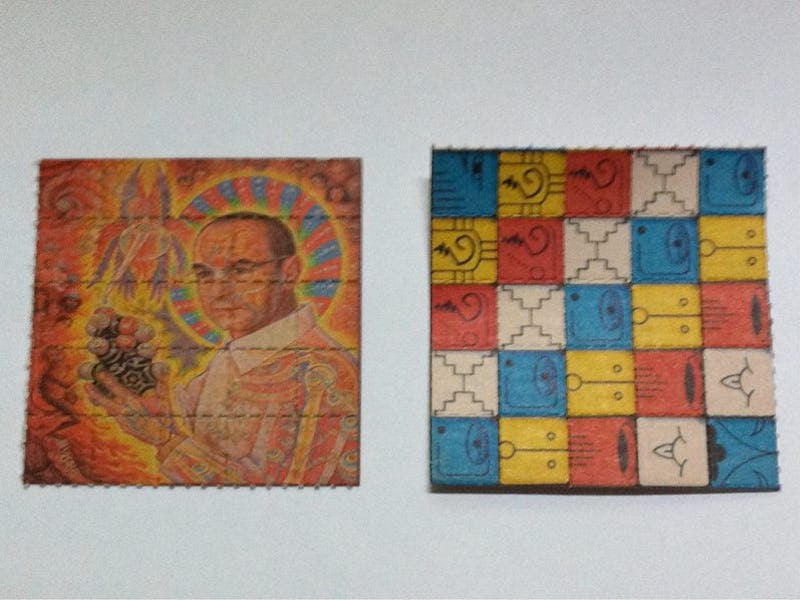Happy 79th Birthday, LSD!
Albert Hoffman first synthesized the chemical on November 16, 1938.

Swiss chemist Albert Hoffman was not trying to develop a mind-altering drug when he synthesized D-lysergic acid diethylamide-25 — better known as LSD — at the Sandoz laboratories in Basel, Switzerland on November 16, 1938.
But his discovery and subsequent self-testing of the chemical opened a door to a revolution that he could never have expected. Throughout the 1940s and 1950s, right through to the psychedelic heyday of the 1960s, psychiatrists, spiritual seekers, and the intelligence community sought to harness the unique characteristics of LSD for healing, understanding, and most notoriously, mind control.
Before the social stigma brought by the war on drugs pushed LSD and other psychedelic drugs underground, the chemical was poised for rather widespread acceptance.
Leading man Cary Grant was famously a proponent and recipient of LSD-assisted psychotherapy. In the 2017 documentary Becoming Cary Grant, a narrator quotes the actor explaining how LSD-assisted therapy helped him get past his harmful behavior patterns and work through his long-held abandonment issues.
“The action of the chemical releases the subconscious so that you can see what transpires in the depth of your mind,” said Grant. “LSD made me realize that I was killing my mother through my relationships with other women. I was punishing them for what she had done to me.”
Before Grant ever dropped acid, though, Hoffman was investigating organic compounds derived from ergot fungus, a rye crop pest. Specifically, when he synthesized LSD, he was trying to synthesize a respiratory and circulatory stimulant. This initial synthesis didn’t yield any huge breakthroughs, though, and he all but set the molecule aside.
Actor Carey Grant dropped LSD more than 100 times.
Five years later, Hoffman felt the need to felt the need to revisit the molecule. This time, he accidentally got some of it on his hand, and since LSD is so potent that a person can absorb an active dose through their skin, he became the first person to experience the mystical state induced by LSD. Here’s how he described it:
…affected by a remarkable restlessness, combined with a slight dizziness. At home I lay down and sank into a not unpleasant intoxicated-like condition, characterized by an extremely stimulated imagination. In a dreamlike state, with eyes closed (I found the daylight to be unpleasantly glaring), I perceived an uninterrupted stream of fantastic pictures, extraordinary shapes with intense, kaleidoscopic play of colors. After about two hours this condition faded away.
Once he realized the drug’s potential, Hoffman’s next step was intentionally ingesting it. He estimated that a threshold dose — just enough to feel the drug — was about 250 micrograms. He was way off, though, as a threshold dose of LSD is closer to 20 micrograms. Quite abruptly, he was deep in the otherworldly realm of the LSD experience. In the midst of this new experience, Hoffman had to ride his bicycle home because World War II was raging through Europe, so motor vehicle usage was restricted. After some initial paranoia, and even a visit from his doctor, Hoffman settled into his first full-on trip in the comfort of his home.
A photo of LSD uploaded to Flickr.
For the rest of his life, Hoffman was a believer in the healing potential of LSD. Even after it gained a bad reputation through Richard Nixon’s war on drugs, Hoffman believed it could be restored in the public eye. In an interview with psychiatrist Charles Grob, who now researches psychedelics at UCLA, Hoffman expressed his optimism. He saw clinical trials on the horizon and had met with some of the leading minds. His hope was tempered with some trepidation, though, especially around the way that psychedelics had become the sacrament of the counterculture.
“It is unfortunate, but for many years these drugs became taboo,” he told Grob. “Hopefully, these same problems from the Sixties will not be repeated.”
Albert Hoffman died in 2008. He was 98 years old.